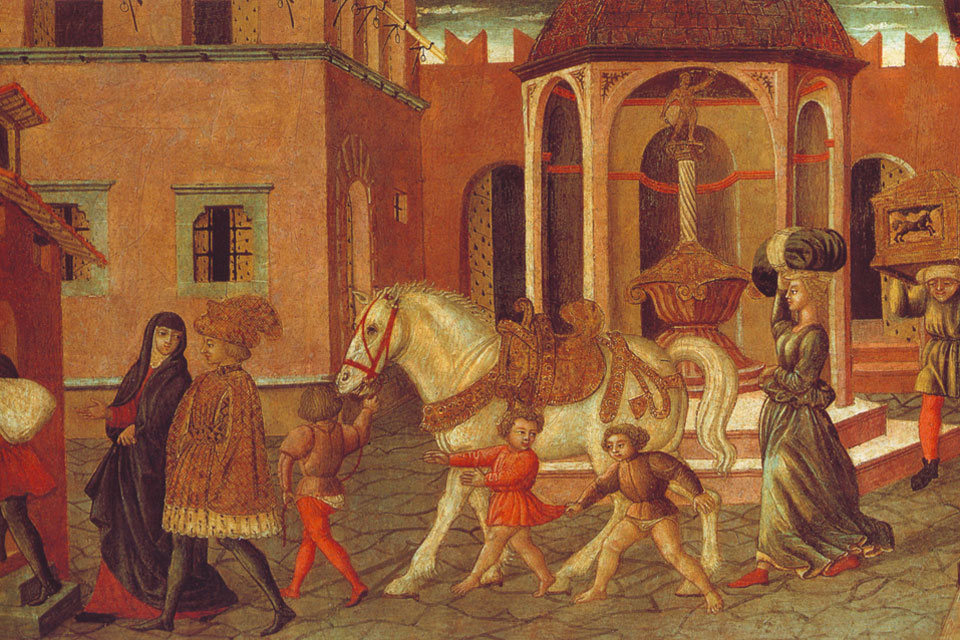Cassoni are known as bridal chests made in Italy from the 14th to the 16th centuries. Lavishly painted and decorated, they came in pairs of two and were gifted by the groom to the bride.
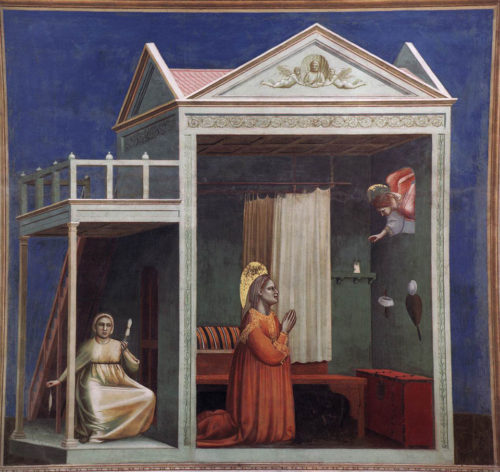
Originally, cassoni were called forzieri da sposa, from forziere, meaning coffers with locks. The earliest cassoni were simple structures with rounded lids like the one painted by Giotto in the Annunciation of St. Anne in Padua. The lids of these chests were covered in textiles and made in Florence.
Later, in the end of the 14th and in the beginning of the 15th century, frontals were painted with narrative scenes and sometimes embellished with pastiglia. At this point painted scenes and low relief decorations of emblems made of gilded gesso or white lead (pastiglia) vied with each other.
Soon after, however, painted scenes took over and more prominent artists began to be in high demand for the production of these luxurious articles.
Such cassoni were typically commissioned by the groom and sent to his future bride. She would then fill them with her trousseau. As part of her wedding the two elaborately decorated chests would be carried in procession to her new home, the final public act, which confirmed to the wider society that the marriage had taken place. The chests would be placed in pride of place, the marriage- or main bedchamber, and would hold her trousseau and other valuables, while the marriage was finally consummated. Often the inside rendered the patterns of the textiles intended to be kept safe in the cassoni. However, enticing paintings showing off nude persons or cute putti are thought to represent a kind of enticing erotica.
Although known from both Siena and Venice, the tradition of gifting chests to the bride as part of the decoration of the new home was typically Florentine. It has been argued that the reason behind this was the Florentine laws, which curtailed the Morgincap or Morning Gift to 50 lira (or 13 – 15 florins). This created the need for the wealthy to compensate by inventing new forms of gifts, which turned out to be fine clothes and jewellery plus caskets to carry it all in.
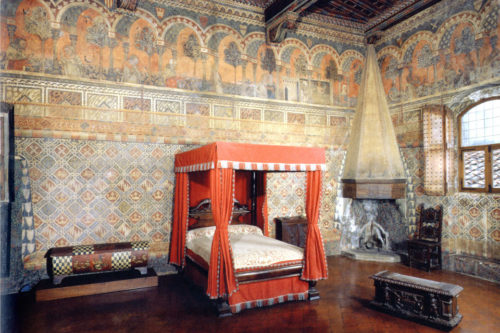
Many of these pieces were decorated in the Late Gothic Style on the brink of the Renaissance and typically features couples walking in the Garden of Love. Inspirations might be had from the novellas of Bocccio’s Caccia di Diana or Ninfale Fiesolana. Others found inspiration in classical tales about heroines exposing conjugal virtues such as marital fidelity, family and civic duty, The inside of the chests were painted with elaborate textile patterns mimicking the textiles which lined the chests. Others had the man and the woman painted inside the lid. One of the enduring qualities of these chests are their secular character showing scenes from the daily life in late medieval and early renaissance Florence.
One of the artists, whose cassoni have been preserved, is Giovanni dal Ponte. From his tax records we know about the price of some of these chests, which amounted to between 20 – 25 Florins (the equivalent of the yearly pay for a rural worker). some artists, like Appollonio de Giovanni di Tommaso spicialised nearly entirely in the production of these bridal chests. It is from his and his partners account-books we know some dtails about the production. First of all, the cassoni seems to have come in pairs. It would take about two months to paint the frontal
Nevertheless, the vast majority of the preserved cassoni or panels defy attribution, since they were part of the daily bread and butter of artistic workshops looking for ways to finance assistants.
Gradually, the paintings on the front of the cassoni were turned into panels intended to hang on the walls and the later cassoni became elaborate chests embellished with classical cornices, mouldings, volutes and pilasters. From this point on, classical myths came to dominate the subjects depicted in the panels, although they gradually gave in to pure architectural chests. These chests were made with decoration in pastiglia. Later, in the 16th century, the cassoni began to be carved in wood and made to look like sarchophagi.
Known artists, who painted cassoni
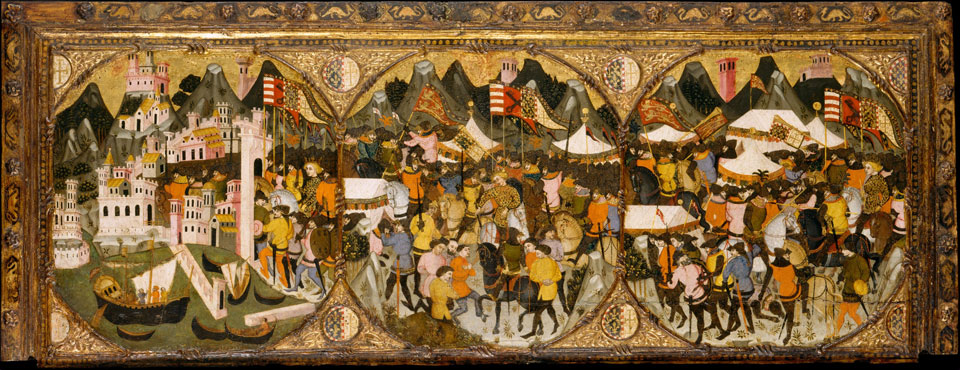
Painted in Florence about 1400, this elaborately decorated front of a chest (cassone) recounts in three episodes the conquest of Naples by Charles III of Durazzo, who defeated the forces of Otto of Brunswick in 1381. At the right, the armies clash; in the center, Otto’s troops (recognizable by their distinctive haircut) surrender to Charles; at the left, the victors enter the conquered city. The prominent pennants and coats of arms in the spandrels are those of the Durazzo and the kings of Hungary. Whether or not this was painted as the front of a marriage chest is speculative. Charles III had already married in 1370, ten years before the conquest took place. However, it represents an early example of a painted chest.

This chest, painted by Giovanni Toscani, was made for the marriage of Giacomo di Berto Fini and Giacoma di Filippo Aldobrandini, who were married around 1417-1418. It depicts groups assembled in the Piazza della Signoria for the Festa dell´Omaggio (Festival of Homage), in which there would be an offertory procession to the Baptistery. Why this theme was chosen by the bridal couple remains obscure. However, it does represent one of the types of scene, which might also be found on cassoni.
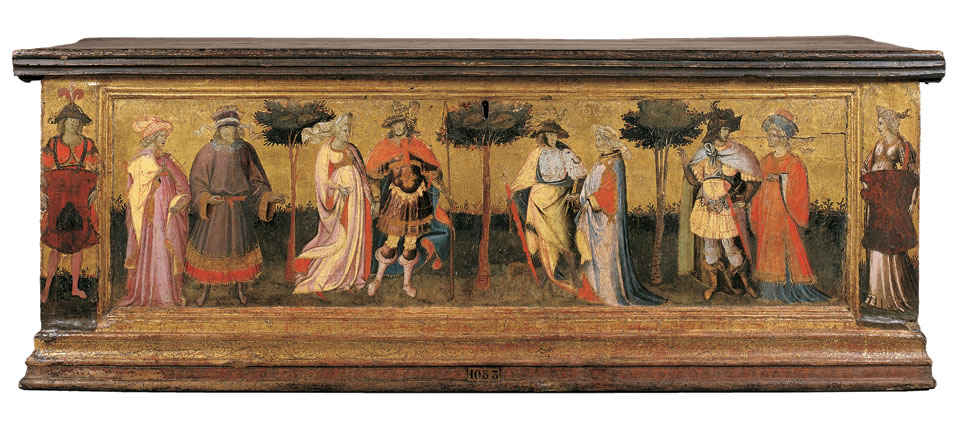
Giovnani dal Ponte is known as a painter bridging the styles of Late Gothic and Early Renaissance. He has left a number of impressive frontals, retables and other painting. But he is also known for his production of Cassoni, which is known from his tax records. One such cassone is preserved in Paris and depicts pairs of lovers, in full length, strolling across a meadow full of flowers. Some represent ancient heroes like Paris and Helen, others are believed to be Tristan and Iseult. Immortal lovers, dressed in fantastical clothes, in flowery Elysian Fields, were often painted by Giovanni dal Ponte on his cassoni, which proves that it must have been a popular theme. Giovanni dal Ponte: Cassone or Bridal Chest: Garden of Love.Ca. 1430 – 35. Paris, Institut de France, Musee Jacquemart-Andre

The Cassone Adimari from c. 1450 was according to the tradition, the front panel of a wedding chest. The scene depicts the prestigious Martelli-Adimari union which was celebrated c. 1440. Recent studies report that the nuptial parade was not made for a wedding coffer “cassone”, but rather for a panel inserted in one of the “spalliere” or wooden wainscoting often used in the 15th century to line the walls of the nuptial chamber. It is attributed to the younger brother of Masaccio, nicknamed “Lo Scheggia” (Giovanni di ser Giovanni, detto Lo Scheggia)
The painting represents an elegant wedding dance taking place in downtown Florence, as witnessed by the Baptistry of St. John the Baptist in the background. In the center, a line of noblemen and noblewomen paired in couples move in a graceful dance under a colorful canopy, accompanied by musicians playing trumpets under the small loggia on the left. Under the same loggia, two young servants carry a bowl and a footed dish into a house. The Florentine garments made of beautiful brocades show patterns created with silver and golden threads

Esther, the Jewish queen of the Persian ruler Ahasuerus (Xerxes), provided a template of courage and virtue by saving her countrymen from a plot to kill them. On this front of a chest (cassone) her marriage feast is depicted as though taking place in fifteenth-century Florence. The princes of the land arrive together with Ahasuerus, who is also shown beneath the portico marrying Esther and then again saluting her at table. The buildings relate closely to contemporary Florentine architecture. The workshop, led by Marco del Buono Giamberti and Apollonio di Giovanni di Tomaso, that produced this panel about 1460–70, was the most prestigious of its kind in the city. This panel outlines the first elements of the Florentine marriage ceremony with the giving of the ring and the accompanying feast. Probably, the second chest would have told the story of the procession of the married couple to their new home and the bedding taking place in the nuptial chamber. The panel is carefully divided into three spatial zones and represents a fine rendering of some of the movements involved in the Florentine marriage ceremonial.
SEE MORE:
Where to see Cassoni in Florence:
Museo Horne
Via dè Benci, 6,
50122 Florence, Italy
Palazzo Davanzati
Via di Porta Rossa, 13,
50122, Florence, Italy
READ MORE:
Renaissance Cassoni, Masterpieces of Early Italian Art: Painted Marriage Chests 1400–1550
By Graham Hughes
London, Art Books Int. ltd. 1997
Art, Marriage, and Family in the Florentine Renaissance Palace
By Jacqueline Marie Mussachio
New Haven, Yale University Press, 2009
The Triumph of Marriage: Painted Cassoni of the Renaissance (exh. cat. by C. Baskins, Boston, MA, Isabella Stewart Gardner Mus.; Sarasota, FL, Ringling Mus. A.; 2008 )
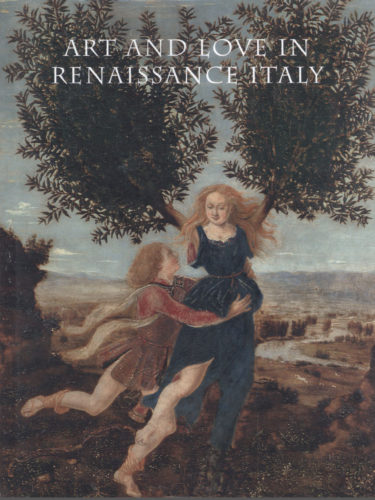 Art and Love in Renaissance Italy
Art and Love in Renaissance Italy
ed. A. Bayer
New York, the Metropolitan 2008
